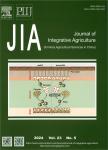Nitrogen in Relation to Photosynthetic Capacity and Accumulation of Osmoprotectant and Nutrients in Brassica Genotypes Grown Under Salt Stress
Nitrogen in Relation to Photosynthetic Capacity and Accumulation of Osmoprotectant and Nutrients in Brassica Genotypes Grown Under Salt Stress作者机构:Department of Botany & Microbiology College of Science King Saud University Plant Physiology Section Department of Botany Aligarh Muslim University
出 版 物:《Agricultural Sciences in China》 (中国农业科学(英文版))
年 卷 期:2010年第9卷第5期
页 面:671-680页
核心收录:
主 题:Brassica juncea L. carbonic anhydrase activity malondialdehyde net photosynthetic rate osmoprotectants,salt stress
摘 要:Different strategies of the application of nutrients are required to overcome the adverse effects of mustard (Brassica juncea L.) in response to NaCl stress. The objective of the present study was to determine if different added levels of nitrogen (N) in growth medium could alleviate the adverse effects of salt stress on photosynthetic capacity and accumulation of osmoprotectants and nutrients. 14 days mustard seedlings of salt-sensitive (cv. Chuutki) and salt-tolerant (cv. Radha) genotypes were fed with: (i) 0 mmol L^-1 NaCl + 0 mg N kg^-1 sand (control), (ii) 90 mmol L^-1 NaCl + 30 mg N kg^-1 sand, (iii) 90 mmol L^-1 NaCl +60 mg N kg^-1 sand, (iv) 90 mmol L^-1 NaCl +90 mg N kg^-1 sand and (v) 90 mmol L^-1NaCl+ 120 mg N kg^-1 sand. Under the condition of salinity stress, N application caused a significant ameliorative effect on both genotypes with respect to growth attributes [fresh weight (FW) and dry weight (DW)] and physio-biochemical parameters [percent water content (WC), net photosynthetic rate (PN), stomatal conductance (gs), total chlorophyll (Ch1), carbonic anhydrase (CA) activity and malondialdehyde (MDA), nitrogen (N), potassium (K) and sodium (Na) contents, and K/Na ratio] and yield attributes (number of pods/plant, seeds/pod and seed yield/plant). The salt-tolerant genotype exhibited maximum value for growth, physio-biochemical and yield attributes at 60 mg N kg 1 sand than that of salt-sensitive genotype. These results suggest that application of N may ameliorate most of the attributes and prove to be a physiological remedy to increase the tolerance against the ill effects of salt stress in Brassicas.



